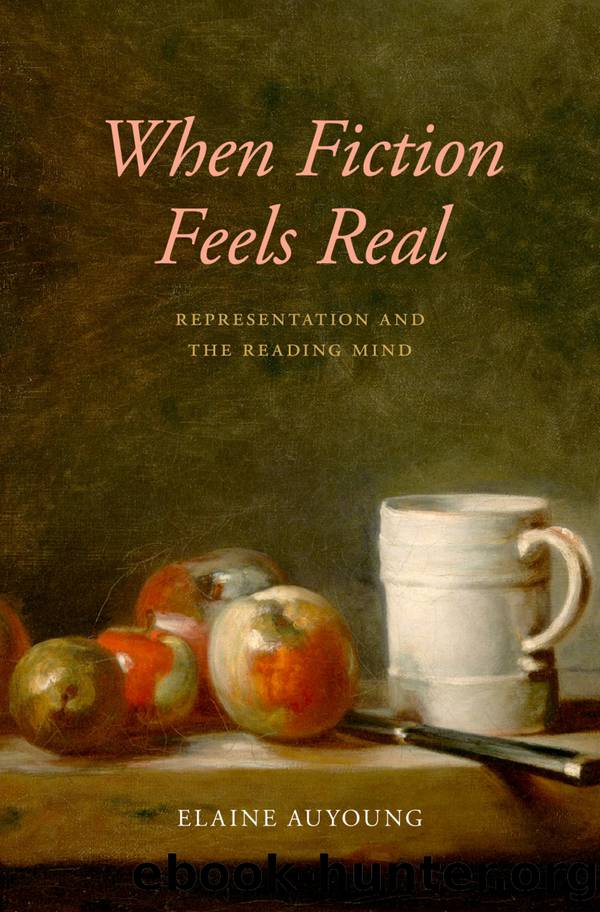When Fiction Feels Real by Auyoung Elaine;

Author:Auyoung, Elaine;
Language: eng
Format: epub
Publisher: Oxford University Press, Incorporated
Published: 2018-08-15T00:00:00+00:00
The notion that one cannot know what it is like to catch a ball on the basis of a verbal description alone recalls Eliotâs claim that readers cannot fully understand the particular charms of âa bright spring dayâ without having experienced one. There are some forms of knowledge that verbal representation can only hint at, such as sensory imagery, bodily movements, and affective states.
Eliot reiterates the imperfect correspondence between language and lived experience in Middlemarch, during a conversation between Dorothea Brooke and her sister Celia. Toward the novelâs conclusion, Celia muses that âit would be pleasant to hear the storyâ of how Dorothea fell in love with Ladislaw, saying, âI cannot think how it all came about.â Yet when Celia presses, âCanât you tell me?â Dorothea replies, âNo, dear, you would have to feel with me, else you would never know.â26 This response to her sisterâs request suggests that even the capacity for verbal representation to kindle fellow feeling has its limits. As much as Celia might enter into the story of how Dorotheaâs engagement to Ladislaw came about, she can never truly know what happened without being able to âfeel withâ Dorothea firsthand. By means of this exchange, Eliot raises the fundamental epistemological problem of âhow well we can know what we donât experience directly,â which is a problem that novel readers also face.27
Regardless of how carefully readers attend to the secondhand report that a literary text provides, there is no way for them to come into firsthand contact with the discrete objects and experiences it represents. In âBelles Lettres,â Eliot cites Lessingâs observation that it is âone thing to be told that some one shrieked, and another to hear the shriek itself.â28 She then goes on to explain that, whereas dramatic representation appeals directly to the senses, ânarrative is a suggestion, and addresses the imagination only.â29 Because realist writers can present readers with only a âsuggestionâ of what they seek to depict, there is always more to the fictional world than readers can ever know. It is perhaps for this reason that, even when the narrator of Adam Bede pretends to give the reader access to the novelâs interior spaces, she invariably positions her reader at the threshold of doorways and windows. Audrey Jaffeâs discussion of this technique calls attention to how the conscripted reader is permitted to âlookâ at the spaces depicted in the text but barred from actually entering them.30 In effect, Eliot dramatizes within the text a readerâs delimited position of having only secondhand access to the fictional world. To be a reader is figuratively to be someone on the outside looking in. Whereas the reader inscribed into the pages of Adam Bede is prohibited from stepping inside rooms that can be apprehended only from a distance, actual novel readers are divided from the fictional world by an epistemological and ontological barrier constituted by the text itself.
Knowing that oneâs access to fictional persons and scenes is fundamentally circumscribed has affective consequences of its own. For
Download
This site does not store any files on its server. We only index and link to content provided by other sites. Please contact the content providers to delete copyright contents if any and email us, we'll remove relevant links or contents immediately.
4 3 2 1: A Novel by Paul Auster(11788)
The handmaid's tale by Margaret Atwood(7447)
Giovanni's Room by James Baldwin(6808)
Asking the Right Questions: A Guide to Critical Thinking by M. Neil Browne & Stuart M. Keeley(5355)
Big Magic: Creative Living Beyond Fear by Elizabeth Gilbert(5351)
Ego Is the Enemy by Ryan Holiday(4954)
On Writing A Memoir of the Craft by Stephen King(4661)
The Body: A Guide for Occupants by Bill Bryson(4580)
Ken Follett - World without end by Ken Follett(4441)
Bluets by Maggie Nelson(4259)
Adulting by Kelly Williams Brown(4231)
Eat That Frog! by Brian Tracy(4147)
Guilty Pleasures by Laurell K Hamilton(4116)
White Noise - A Novel by Don DeLillo(3828)
The Poetry of Pablo Neruda by Pablo Neruda(3813)
Fingerprints of the Gods by Graham Hancock(3731)
Alive: The Story of the Andes Survivors by Piers Paul Read(3728)
The Book of Joy by Dalai Lama(3694)
The Bookshop by Penelope Fitzgerald(3616)
